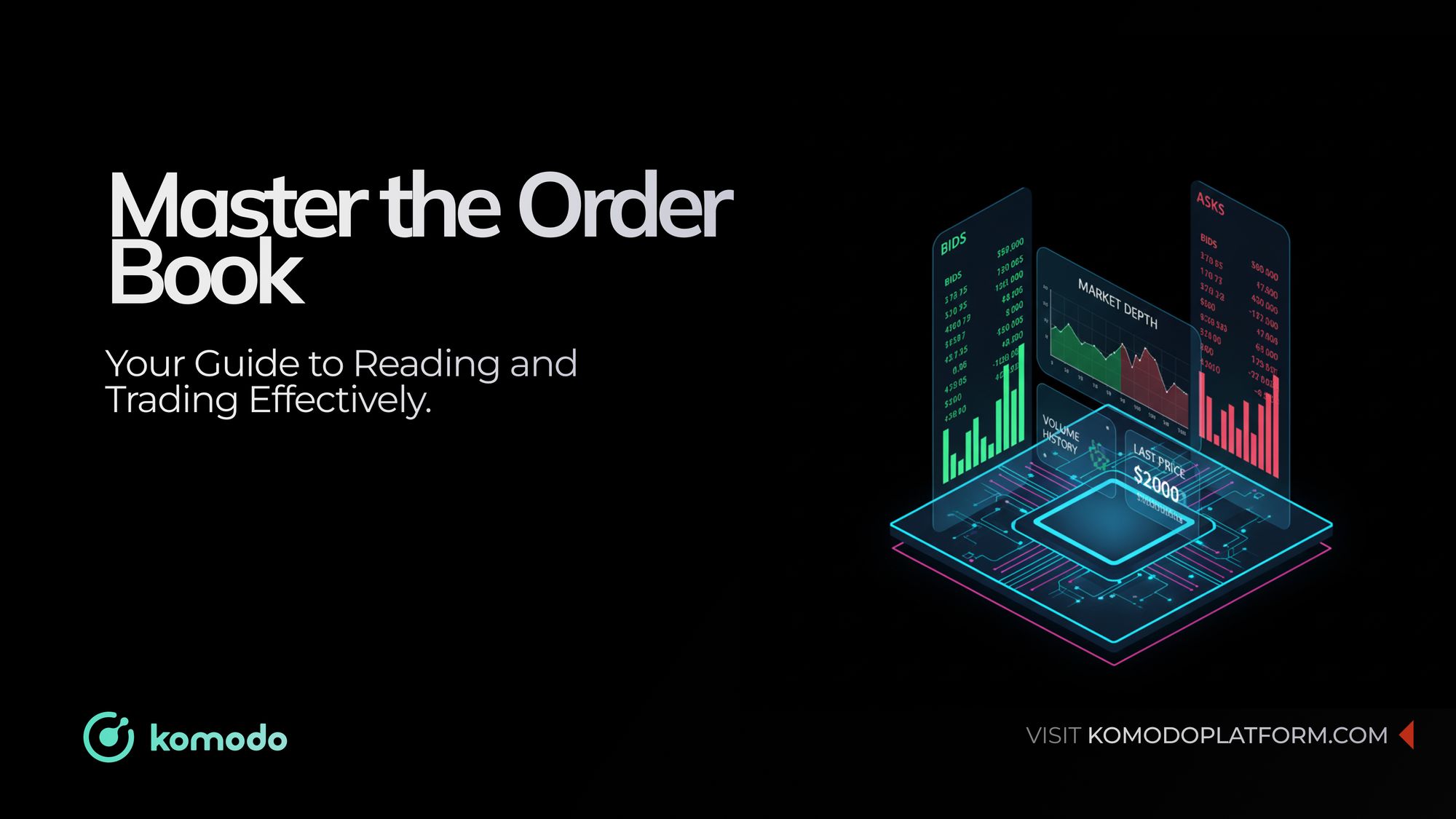Every successful trader knows that understanding how orders are placed and executed can make a big difference in trading results. That’s where reading order books becomes essential. Order books give traders real-time insight into market activity, showing who’s buying, who’s selling and at what price. On Komodo Platform, learning to use order books effectively helps you trade confidently and make better decisions in a trustless, decentralized environment.
What is an Order Book
An order book is a real-time, continuously updated list of all outstanding buy (bid) and sell (ask) orders for a specific trading pair, showing price levels and order quantities. It shows what prices traders are willing to pay (bids) and what prices others are asking for (asks).
Here’s how it works:
- Buy Orders (Bids) - The prices and volumes traders are willing to pay to purchase the asset.
- Sell Orders (Asks) - The prices and volumes at which traders are willing to sell.
- Spread - The difference between the highest bid and the lowest ask - this shows how close buyers and sellers are to agreeing on a price.
For example, if buyers are bidding 0.095 BTC for 1 KMD and sellers are asking 0.096 BTC, the spread is 0.001 BTC. The smaller the spread, the more active and liquid the market.
Understanding Market Depth
Market depth measures how much liquidity exists at different price levels. It shows how many buy and sell orders are stacked above and below the current market price.
A deep market, one with many orders and high trading volume, indicates strong liquidity. That means you can make larger trades without causing significant price changes.
Komodo Exchange's order book interface clearly displays market depth by allowing traders to identify significant buy or sell walls and assess available volume and aiding in anticipating the market impact of their trades.
How to Read an Order Book
Learning to read order books takes a bit of practice, but once you understand the layout, it becomes a powerful trading tool.
Here’s a quick overview:
- Price Column - Displays price points at which orders are placed.
- Amount Column - Shows the quantity of the asset traders want to buy or sell at each price level.
- Color Coding - Highlights bids (buy orders) in green and asks (sell orders) in red to visually distinguish between demand and supply.
- Order Book Spread - The difference between the highest bid price and the lowest ask price, reflecting market liquidity and trading activity.
- Price Walls - Large clusters of buy or sell orders that can act as support or resistance levels.
Example: If you notice a large buy wall at 0.094 BTC, it might indicate strong support - many traders are willing to buy at that level, which can help stabilize the price.
Effective order book reading helps traders spot momentum trends, potential reversals and optimal entry or exit points by analyzing changes in order flow and price levels.
Using Order Book Analysis in Trading
Order book analysis helps traders interpret the data behind buy and sell orders to make better decisions. By examining how the order book changes over time, you can spot key signals such as:
- Price Momentum - Increasing buy orders may suggest rising pressure.
- Resistance Levels - Large sell walls could slow or stop a price rally.
- Liquidity Trends - Shifts in market depth show when trading conditions are tightening or loosening.
For Komodo Wallet users, order book analysis becomes even more valuable. It provides live, native order books across multiple blockchains - no wrapped assets or third-party custody. This means you can perform accurate, trustless analysis while trading securely between real assets.
Benefits of Order Book Trading on Komodo Exchange
Order book trading provides users with improved control, transparency and market visibility, vital for informed trading. Komodo Platform amplifies these advantages through its native decentralized infrastructure, enabling trustless, peer-to-peer transactions.
Here are some of the key advantages:
- Native Asset Trading - Komodo Exchange allows trading of real blockchain assets directly without relying on wrapped or synthetic tokens, ensuring authenticity and verifiability on-chain.
- True Decentralization - Trades occur peer-to-peer through Komodo Platform's atomic swap technology. This means no intermediaries, custodians or bridge risks, making it fully trustless and secure.
- Transparent Order Execution - The public order book on Komodo Platform shows every order and trade, allowing users full visibility into transaction fairness and absence of manipulation.
- Access to Multi-Chain Liquidity - Komodo Platform connects liquidity across multiple blockchains (UTXO-based, EVM-based, Cosmos-based), enabling traders to find better prices and opportunities across diverse assets in one platform.
Together, Komodo Platform and Komodo Exchange provide a seamless, trustless trading experience. With full visibility into order activity and market depth, users can make informed, transparent trades without giving up control of their assets.
Key Takeaways on Order Books
Mastering the art of reading order books is an essential part of becoming a well-informed trader. It reveals the hidden dynamics of supply and demand by helping you understand liquidity, momentum and potential price movements. By combining insights from order book analysis and market depth, you can make more precise trading decisions and respond confidently to market changes.
Whether you’re trading on centralized or decentralized platforms, understanding order books equips you with the clarity needed to manage volatile markets and make strategic moves based on real market data.
Start trading securely with Komodo Wallet today, where native, cross-chain trading meets full transparency.
